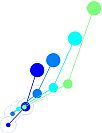Among non-human primates, macaques are recognized for thriving in a wide range of novel environments. Previous studies show macaque's affinity for new information. However, little is known about how information-seeking manifests in their spatial navigation pattern in ambiguous foraging terrains, where the location and distribution of the food are unknown. We investigated the spatial pattern of foraging in free-moving macaques in an ambiguous terrain, lacking sensory cues about the reward distribution. Rewards were hidden in a uniform grid of woodchip piles spread over a fifteen sqm open terrain and spatially distributed according to different patchy distributions. We observed Lévy-like random walks in macaques' spatial search pattern, balancing relocation effort with exploration. Encountering rewards altered the foraging path to temporarily favor the vicinity of discovered rewards without preventing longer-distance travels. These results point toward continuous exploration, suggesting that explicit information-seeking is a part of macaques' foraging strategy. We further quantified the role of information seeking using a kernel-based model, combining a map of ambiguity, promoting information seeking, with a map of discovered rewards and a map of proximity. Fitting this model to the foraging paths of our macaques revealed individual differences in their relative preference for information, reward, or proximity. The model predicted that a balanced contribution of all three factors performs and adapts to an ambiguous terrain with semi-scattered rewards, a prediction we confirmed using further experimental evidence.
While manual sampling is the only information-seeking method for a solo forager on an ambiguous terrain, group foragers additionally learn about the terrain by observing others. We allowed two adult male members of a macaque social group to perform a spatial foraging task together. One of the macaques was task-expert, meaning that he had performed 10-20 sessions of the solo task described above. Therefore, even though he did not know the location of the food, he was aware of the relatively low likelihood of finding food. The other macaque was task-naïve, meaning he had experienced a high-yield terrain in which all piles were filled but not a low-yield terrain in which 20% or less of the piles were filled. We investigated the proportion of time each monkey spent in various behavioral states, such as foraging, observing partners, or looking around. We found that the task-naïve animal spent considerable time observing his task-expert partner, while the task-expert macaque spent more time foraging and less observing. Over the sessions, the task-naïve macaque transitioned from observing to foraging, leading to a hypothesis that the observations were relevant for learning the foraging task. To test this, we quantified the causal effect of the task-expert's momentary search actions on the task-naïve momentary look actions using local transfer entropy. We found a significant elevation in transfer entropy in early foraging sessions for the task-naïve animal but not in the late sessions or for the task-expert monkey. These preliminary results confirmed task-relevant observation, providing evidence for information seeking via a foraging partner in our study. Taken together, we postulate an explicit role for seeking information as a valuable entity to reduce ambiguity in macaques' foraging strategies, suggesting an ecologically valid way of foraging ambiguous terrains.
Funding/support: MWK Lower Saxony ZN3422 “DeMoDiag”, DFG CRC-1528 “Cognition of Interaction”, Leibniz ScienceCampus Primate Cognition (W45/2019 – Strategische Vernetzung).

 PDF version
PDF version
